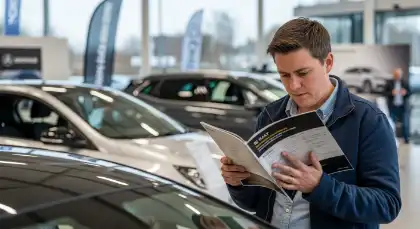Negotiating the best price on a used car is crucial for getting the most value out of your purchase. The ability to negotiate effectively can save you hundreds or even thousands of dollars, making a significant impact on your overall investment.
Key strategies for negotiating used car prices include:
- Research and Preparation: Knowing the fair market value of the car you want gives you a strong starting point.
- Price Negotiation Tactics: Starting with a low offer and making incremental counteroffers helps you stay within budget.
- Dealership vs. Private Party Negotiations: Understanding the differences in negotiation dynamics between dealerships and private sellers is essential.
- Payment Considerations: Using cash or comparing financing options can provide leverage in negotiations.
- Patience and Timing: Taking your time ensures you make a well-informed decision without overpaying.
By mastering these strategies, you position yourself to secure the best possible deal on your next used car.
1. Research and Preparation

Thorough research before buying a used car sets the tone for every step that follows. Knowledge is your primary tool—sellers expect buyers to walk in informed about the vehicles they’re considering.
Start with Market Value Research
- Use trusted sources like Kelley Blue Book and Edmunds to determine the fair market value of any used car. These platforms provide pricing based on year, make, model, mileage, and condition.
- Enter vehicle details into both sites. Note the differences between retail, trade-in, and private party values. This data gives you a realistic price range and prevents overpaying.
Create Leverage with Multiple Sellers
- Cast a wide net by identifying several cars that meet your criteria from different sellers.
- Let each seller know you are exploring other options. This makes you a more attractive buyer and increases your bargaining power since sellers know you have alternatives.
Simplify with a Pre-Approved Auto Loan
- Secure a pre-approved auto loan for used cars from banks or credit unions before stepping onto a lot or meeting with private sellers.
- A pre-approval clarifies your budget limits and speeds up negotiations, as you’re seen as a serious buyer who’s ready to close quickly.
- Presenting your own financing can also give leverage if the seller offers less favorable terms.
Leverage Vehicle History Reports
- Obtain a comprehensive vehicle history report for used cars using the car’s VIN through services like Carfax or AutoCheck.
- Look for red flags, such as accident history, title issues, odometer discrepancies, or missed maintenance. Each documented issue becomes a negotiation point for lowering the price or asking for repairs.
- Bring up these findings directly during discussions—facts from these reports often carry more weight than opinions or feelings about the car.
Research before buying a used car is not just about finding information; it’s about transforming that information into negotiating power. With facts at your fingertips and evidence in hand, you walk into every conversation ready to drive the deal in your favor.
2. Price Negotiation Tactics
Negotiation tactics for buying a used car can make the difference between paying full price and driving away with a true bargain. The process starts before you even say a word to the seller. Armed with research, you’ll want to set your opening offer at the low end of your calculated market value, but it has to be realistic based on condition and comparable listings.
- Start with a number that’s lower than your target, but not so low that it offends the seller or ends negotiations prematurely.
- A realistic low offer signals that you know the market, but that you’re also open to reasonable discussion—not just fishing for an impossible deal.
Making counteroffers when buying a used car is where momentum builds. Don’t leap straight to your maximum budget if your first offer gets declined. Use incremental increases:
- Raise your offer in small steps—$250 or $500 at a time—leaving clear room for ongoing negotiation.
- If the seller counters, respond with your own counteroffer rather than simply accepting or rejecting outright.
- Each move should bring you closer to your target price, but never reach it until the very end of the talks.
Clarity matters. Write down each offer and counteroffer during discussions. When numbers are in writing—on paper or as a note on your phone—it reduces confusion and keeps both parties honest.
Using silence during negotiations is an underrated tactic. After making an offer, resist the urge to fill the quiet space.
Silence puts subtle pressure on the seller, giving them time to consider your offer seriously and sometimes prompting concessions without extra effort on your part.
A calm pause after stating your price can be more persuasive than any argument or justification.
These tactics work whether you’re negotiating face-to-face or over email or text, setting a strong foundation for what comes next in the buying process.
Incorporating some hardball tactics into your strategy can further enhance your negotiating power.
3. Dealership vs. Private Party Negotiations
Negotiating at dealerships for used cars comes with a distinct set of considerations compared to working with private sellers. Dealerships often advertise a base price that appears competitive, yet the final figure may rise considerably due to additional fees. Expect to see charges such as:
- Documentation fees: Often non-negotiable and can range widely depending on the dealer and state.
- Dealer markups: Sometimes applied to increase profit margins, especially on high-demand models.
- Other miscellaneous costs: Tax, title, registration, and sometimes ambiguous “processing” fees.
Always request a full breakdown of every fee before you agree to a deal. Don’t hesitate to question any line item that seems excessive or unclear.
The finance and insurance office at dealerships introduces another layer of negotiation. After settling on the car’s purchase price, you’ll be offered extras like extended warranties, gap insurance, or maintenance packages. If you already have your own financing or aren’t interested in these add-ons, politely decline or negotiate the price down—these products are often marked up significantly.
When negotiating with private sellers for used cars, the process is usually more straightforward but requires attention to vehicle condition and history. Use any issues discovered during your research or inspection as leverage:
- Point out needed repairs (e.g., worn tires, brake pads, or cosmetic damage).
- Reference recent maintenance not performed (such as timing belt replacement).
- Mention any red flags in the vehicle history report.
A factual approach works best. Show comparable listings in your area, highlight cost estimates for repairs, and explain how these affect your offer.
Understanding how to negotiate the best price on a used car means tailoring your strategy to fit the seller—whether it’s a dealership with structured processes and added fees or a private individual motivated by convenience or urgency.
4. Payment Considerations
Paying cash for a used car gives you instant leverage at the negotiation table. Sellers appreciate the simplicity of a cash transaction—no financing paperwork, fewer delays, and less risk of the deal falling through. When you signal that you’re ready to pay in full, some sellers are more willing to lower their asking price or include extras to close the deal quickly.
1. Cash as a Bargaining Chip
Sellers value certainty. When you offer cash, highlight the immediate nature of your payment and your ability to finalize the sale on the spot. For private sellers, this is especially powerful—they avoid waiting for loan approvals or worrying about bounced checks. Dealerships may also respond favorably, especially if you negotiate late in the month when sales quotas are on their minds.
2. Comparing Dealer Financing Offers
Even if you don’t plan to pay all cash, comparing dealer financing offers for a used car is critical. Dealers often present multiple loan options with varying interest rates and terms. Bring a pre-approved loan offer from your own bank or credit union as a benchmark. When dealers know you have other financing options, they may compete for your business by lowering rates or waiving fees.
“I walked into three dealerships with my credit union’s pre-approval letter in hand. Each one matched or beat my rate before I even started discussing price.”
However, it’s essential to understand that not all financing offers are created equal. Choosing between a bank and a dealership for your car loan can significantly affect your overall financial situation. Careful attention to how you pay—cash or financed—can directly impact not just your monthly cost but also your negotiating position throughout the process.
5. Patience and Timing in Negotiations
Being patient when negotiating for a used car is one of the most powerful tools at your disposal. When you avoid rushing into a purchase, you drastically reduce the risk of overpaying or settling for a subpar deal. Quick decisions often play into the seller’s advantage, especially if they sense urgency or eagerness on your part.
- Taking time to think through offers when buying a used car allows you to compare competing vehicles, evaluate true market value, and reconsider needs versus wants.
- Walking away from a negotiation is not a loss; it’s leverage. Sellers frequently reach out with better terms after seeing a genuine willingness to leave the table.
- The best deals often surface for those who wait—end-of-month quotas, seasonal inventory changes, and even private sellers pressed for a quick sale can shift the price in your favor.
- Silence and pauses during negotiation signal that you’re in control of your decision-making timeline, not pressured by fear of missing out.
“I’ve had sellers drop their price by hundreds just because I didn’t call back right away,” as many buyers have discovered. Patience communicates confidence and gives you time to spot red flags or hidden fees that impulsive buyers might miss.
Staying calm and deliberate in your approach ensures the negotiation remains centered around facts and value—never desperation. This mindset keeps you in command at every stage of the process.
6. Additional Tips for Successful Negotiations

Focusing on numbers and facts in negotiations keeps the process grounded and productive. Emotional appeals or stories from sellers can cloud judgment and distract you from your goal: securing the best price. Insist on discussing objective data such as:
- Market value from sources like Kelley Blue Book or Edmunds
- Comparable listings in your area
- Documented repairs or maintenance needs
Silence is an underrated negotiation tool. After making an offer or responding to a counter, pause and allow the seller time to process. Salespeople and private sellers often feel compelled to fill the silence, sometimes with concessions or lower prices.
Understanding depreciation in cars arms you with evidence during pricing discussions. Most vehicles lose a significant portion of their value within the first few years—often as much as 20% in the first year alone. Use this knowledge when a seller tries to justify a higher price based on what they originally paid.
Understanding how to negotiate the best price on a used car means relying on research, maintaining composure, and leveraging every factual advantage. When you focus on numbers, use silence effectively, and understand how depreciation impacts value, you put yourself in the strongest position to negotiate a deal that truly benefits you.

